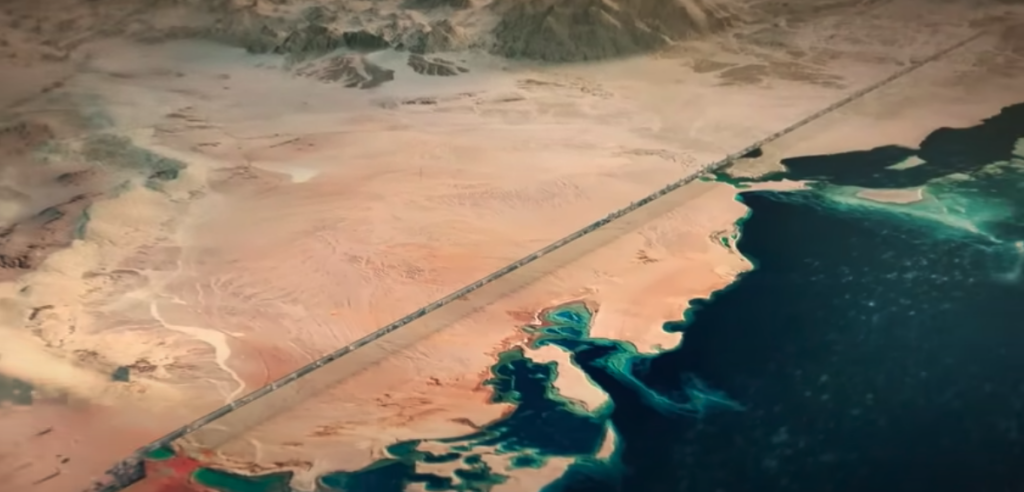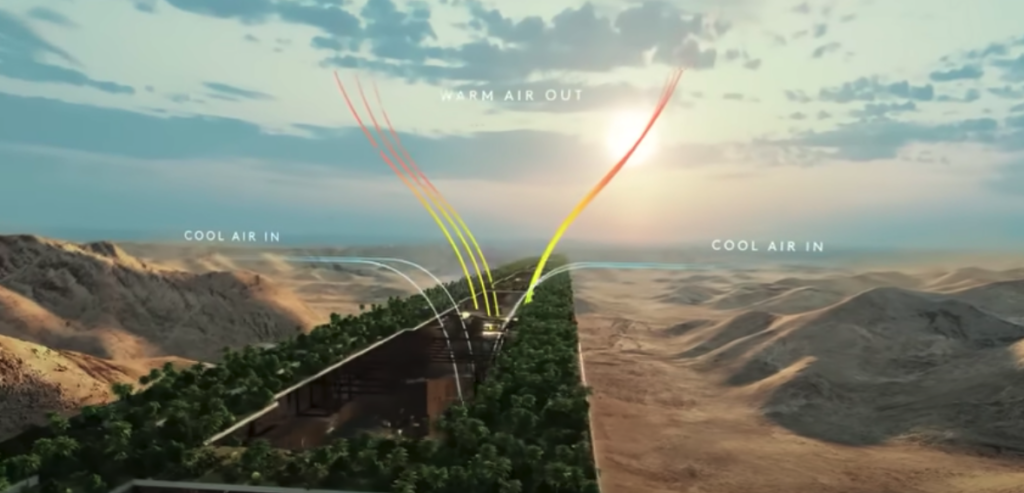Construction has started on city-sized building The Line. It could be one of the most advanced, high-tech environments that’s ever been designed, but will it be conducive to work success?

This article was originally published by Allwork.Space.
News of The Line being built in Saudi Arabia has generated quite the buzz, as well as a million questions, including how it will impact the future of work.
Currently in the excavating phase, The Line will be one massive linear city.
“No roads, cars or emissions, it will run on 100% renewable energy and 95% of land will be preserved for nature. People’s health and wellbeing will be prioritized over transportation and infrastructure,” according to NEOM, one of the projects working on the city.
This city-sized building is meant to provide nearly everything humans could need, including places to live, work, be entertained, and be taken care of when sick.
The Line is meant to accommodate 9 million people, be more than 100 miles long, and 1,650 feet high. Future residents will have access to all essential facilities within a five-minute walk, as well as access to a high-speed rail (with a 20-minute end-to-end trip). The project says it will create 380,000 jobs by 2030.
“The Line will tackle the challenges facing humanity in urban life today and will shine a light on alternative ways to live. We cannot ignore the livability and environmental crises facing our world’s cities,” Mohammed bin Salman, Crown Prince of Saudi Arabia, said of the project.

What does “remote” work mean when you live and work from the same building?
Some of the questions raised by the plans for this new destination: If we have buildings the size of cities, who will work and how will we work? What will remote work look like in that environment?
Within a city with high density, such as this future one, “remote” work will become a very relative term.
If one lives and works from the same building, that technically is remote work. A community/city such as The Line would create an entirely new society — and it will be exciting to see whether or not it becomes successful and prosperous.
If this project works and its residents are content, this may inspire other cities to be built in a similar manner.

City-sized communities aren’t a new concept
Although in theory this may sound like heaven for many workers, this sort of city has been attempted before.
One example is the community of Arcosanti in Arizona (just North of Phoenix).
To make a community/city such as this be successful, many aspects need to be given intense thought and planning. First, the city needs to be conducive to both work and play.
Remote work is extremely popular due to the flexibility and comfort it allows, but not everyone is in a profession that allows for remote work; these communities need to have enough jobs to provide for their residents.
Arcosanti opened in 1970 and was meant to house 5,000 people. Today, it houses less than 150 — which was true from even the beginning of its creation.
Although a failed experiment, its legacy remains, as well as the inspiration it gave for the idea of similar communities.
It’s become a tourist attraction to those who are interested in seeing a failed self-sustaining community. It holds an extreme and brutalist type of beauty though, and it looks truly other-worldly.
Perhaps it was simply just before it’s time, and lacked the proper technology and planning to become sustainable.

What will city-communities mean for the future of how we work, and more broadly, the future of humanity?
One main question that needs to be asked of upcoming projects such as The Line is how society will be divided.
Will there be class divisions within the city-building, or will every resident be held equal? For workers that can’t work remotely/from a computer, what will their roles be? The project says it will contain floors of vertical offices, but what about people who aren’t office workers? Will the community supply them with jobs so they don’t have to leave the site?
As developments are underway for this project, the answers will become clear in the not-so-distant future when people begin moving in 2030. If successfully completed and implemented, this city/community could prove that working and living within the same building is plausible for humankind.
Allwork.Space spoke to Ivo Van Breukelen, who is one of the Managing Partners with the Proptech Connection. The company is the leading global advisory which helps global VC funds, real estate companies and proptechs in sharing global market insights about the proptech ecosystem. Van Breukelen recently visited Saudi Arabia and met representatives of NEOM and the Saudi owner (“PIF”: Public Investment Fund) in the capital of Riyadh.
“The Line is an extremely ambitious project and the largest real estate and construction project globally. The aim is to have amenities within a 15- or 20-minute radius for all residents. The scale of this project is incredible,” he said.
The Line might also be hugely appealing to digital nomads.
“They (the creators of The Line) are looking at (Prop)technologies across the board. The current ecosystem in Saudi to leverage Proptech and Contech is too small to deliver for the quantum and scale that is required for a project of this size. It’s also worth pointing out that The Line is the largest project in KSA, but there’s a few more major projects that are currently in design or in construction phase,” Van Breukelen told Allwork.Space.
When asked if everyone within The Line will have the ability to work remotely, he explained that this will most likely be the case.
“My understanding is that it is the ambition to make this THE city of the future…if you look at the work from home movement, this is not something temporary. The trend is clear if you look at the underlying data, and asset repurposing is one of the biggest opportunities or challenges for asset owners at the moment. We are working with some of the largest asset owners globally providing insights how they can leverage technology in the market to solve commercial problems, hyper-curated to their use-case with a global lens and data-led research,” Van Breukelen said.
As for a balanced work-life, he says “it’s all about sustainability, wellness, and wellbeing.”


